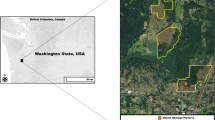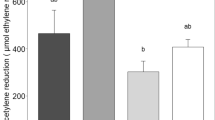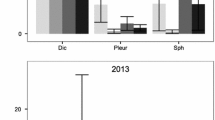Abstract
Nitrogen (N) fixation in moss-cyanobacteria associations is one of the main sources of ‘new’ N in pristine ecosystems like subarctic and arctic tundra. This fundamental ecosystem process is driven by temperature as well as by moisture. Yet, the effects of temperature and moisture stress on N2 fixation in mosses under controlled conditions have rarely been investigated separately, rendering the interactive effects of the two climatic factors on N2 fixation unknown. Here, we tested the interactive effects of temperature and moisture on N2 fixation in the two most dominant moss species in a temperate heath, subarctic tundra and arctic tundra: Pleurozium schreberi and Tomentypnum nitens. Mosses with different moisture levels (25, 50, 100%) were kept at different temperatures (10, 20, 30 °C) and N2 fixation was measured at different times after exposure to these conditions. T. nitens had the highest nitrogenase activity and this increased with moisture content, while effects were moderate for P. schreberi. Nitrogenase activity increased with temperature in all mosses, and the temperature optimum (Topt) was between 20 °C and 30 °C for all mosses. Quick acclimatization towards higher temperatures occurred. Our results suggest that the contemporary and not the historical climate govern the response of moss-associated N2 fixation to changes in the abiotic environment. Thus, climate change will have substantial impacts on N2 fixation in dominant mosses in temperate, subarctic and arctic habitats.



Similar content being viewed by others
References
Ackermann K, Zackrisson O, Rousk J, Jones DL, DeLuca TH (2012) N2 fixation in feather mosses is a sensitive indicator of N deposition in boreal forests. Ecosystems 15:986–998
Antropova TA (1974) Temperature adaptation studies on the cells of some bryophyte species. Tsitologiia 16:38–42
Belnap J (2001) Factors influencing nitrogen fixation and nitrogen release in biological soil crusts. In: Belnap J, Lange OL (ed) Biological soil crusts: structure, function, and management. Ecological studies, vol 150, pp 241–261. Springer, Heidelberg
Carleton TJ, Read DJ (1991) Ectomycorrhizas and nutrient transfer in conifer-feather moss ecosystems. Can J Bot 69:778–785
Coxson DS, Kershaw KA (1983) Rehydration response of nitrogenase activity and carbon fixation in terrestrial Nostoc commune from Stipa-Bouteloua grassland. Can J Bot 61:2658–2668
DeLuca TH, Zackrisson O, Nilsson MC, Sellstedt A (2002) Quantifying nitrogen-fixation in feather moss carpets of boreal forests. Nature 419:917–919
Dilks TJK, Proctor MCF (1975) Comparative experiments on temperature responses of bryophytes: Assimilation, respiration and freezing damage. J Bryol 8:317–336
Ellermann T, Andersen HV, Bossi R et al. (2011) Atmosfærisk deposition. Århus Universitet, pp 18–38, NOVANA
Elumeeva TG, Soudzilovskaia NA, During HJ, Cornelissen JHC (2011) The importance of colony structure versus shoot morphology for the water balance of 22 subarctic bryophyte species. J Veg Sci 22:152–164
Englund B, Meyerson H (1974) In situ measurement of nitrogen fixation at low temperatures. Oikos 25:283–287
Gentili F, Nilsson MC, Zackrisson O, DeLuca TH, Sellstedt A (2005) Physiological and molecular diversity of feather moss associative N2 -fixing cyanobacteria. J Exp Bot 56:3121–3127
Glime JM (2007) Bryophyte Ecology. Volume 1. Physiological Ecology. Ebook sponsored by Michigan Technological University and the International Association of Bryologists. http://www.bryoecol.mtu.edu/. Accessed 01 June 2015
Granhall U (1981) Biological nitrogen fixation in relation to environmental factors and functioning of natural ecosystems. In: Clark FE, Rosswall T (eds) Terrestrial nitrogen cycles, vol 33. Swedish Natural Research Council, Stockholm, pp 131–144
Gundale MJ, DeLuca TH, Nordin A (2011) Bryophytes attenuate anthropogenic nitrogen inputs in boreal forests. Glob Change Biol 17:2743–2753
Gundale MJ, Wardle DA, Nilsson MC (2012a) The effect of altered macroclimate on N-fixation by boreal feather mosses. Biol Lett 8:805–808
Gundale MJ, Nilsson M, Bansal S, Jäderlund A (2012b) The interactive effects of temperature and light on biological nitrogen fixation in boreal forests. New Phytol 194:453–463
Harmens H, Schnyder E, Thöni L, Cooper DM, Mills G, Leblond S et al (2014) Relationship between site-specific nitrogen concentrations in mosses and measured wet bulk atmospheric nitrogen deposition across Europe. Environ Pollut 194:50–59
Hearnshaw GF, Proctor MCF (1982) The effect of temperature on the survival of dry bryophytes. New Phytol 90:221–228
Houlton BZ, Wang YP, Vitousek PM, Field CB (2008) A unifying framework for dinitrogen fixation in the terrestrial biosphere. Nature 454:327–331
Ininbergs K, Bay G, Rasmussen U, Wardle DA, Nilsson MC (2011) Composition and diversity of nifH genes of nitrogen-fixing cyanobacteria associated with boreal forest feather mosses. New Phyt 192:507–517
Isichei AO (1980) Nitrogen fixation by blue-green algae soil cursts in Bigerian svanna. In: Rosswall T (ed) Nitrogen cycling in West African ecosystems. NFR, Stockholm, pp 191–199
Jackson BG, Martin P, Nilsson MC, Wardle DA (2011) Response of feather moss associated N2 fixation and litter decomposition to variations in simulated rainfall intensity and frequency. Oikos 120:570–581
Jones K (1977) Acetylene reduction in the dark by mats of blue-green algae in subtropical grassland. Ann Bot 41:807–812
Karlsson GP, Akselsson C, Hellsten S, Karlsson PE, Malm G (2009) Övervakning av luftföroreningar norra Sverige—mätningar och moddellering. Svenska Miljöinstitut IVL rapport B1851. Lund University
Kershaw KA (1985) Physiological ecology of lichens. Cambridge University Press, London
Li Y, Glime JM (1990) Growth and nutrient ecology of two Sphagnum species. Hikobia 10:445–451
Liu Y, Cao T, Glime JM (2003) The changes of membrane permeability of mosses under high temperature stress. Bryologist 106:53–60
Rousk K, Michelsen A (2016) Ecosystem nitrogen fixation throughout the snow-free period in subarctic tundra: Effects of willow and birch litter addition and warming. Glob Change Biol. doi:10.1111/gcb.13418
Rousk K, Rousk J, Jones DL, Zackrisson O, DeLuca TH (2013a) Feather moss nitrogen acquisition across natural fertility gradients in boreal forests. Soil Biol Biochem 61:86–95
Rousk K, DeLuca TH, Rousk J (2013b) The cyanobacterial role in the resistance of feather mosses to decomposition—toward a new hypothesis. PLoS One. doi:10.1371/journal.pone.0062058
Rousk K, Jones DL, DeLuca TH (2014) The resilience of nitrogen fixation in feather moss (Pleurozium schreberi)-cyanobacteria associations after a drying and rewetting cycle. Plant Soil 374:513–521
Rousk K, Sorensen PL, Lett S, Michelsen A (2015) Across habitat comparison of diazotroph activity in the Subarctic. Microb Ecol 69:778–787
Rousk K, Sorensen PL, Michelsen A (2016) Nitrogen transfer from four nitrogen fixer associations to plants and soils. Ecosystems. doi:10.1007/s10021-016-0018-7
Smith VR (1984) Effects of abiotic factors on acetylene reduction by cyanobacteria epiphytic on moss at a subantarctic island. Appl Environ Microbiol 48:594–600
Staal M, te Lintel-Hekkert S, Harren F, Stal L (2001) Nitrogenase activity in cyanobacteria measured by the acetylene reduction assay: a comparison between batch incubation and on-line monitoring. Environm Microbiol 3:343–351
Stewart WDP, Smapaio MJ, Isichei AO, Sylvester-Bradley R (1977) Nitrogen fixation by soil algae of temperate and tropical soils. In: Döbereiner J, Burris RH, Hollaender A, Franco AA, Neyra CA, Scott DB (eds) Limitations and potential for biological nitrogen fixation in the tropics. Plenum Press, New York, pp 41–63
Stewart KJ, Coxson D, Grogan P (2011) Nitrogen inputs by associative cyanobacteria across a low arctic tundra landscape. Arct Antarct Alp Res 43:267–278
Strickland MS, Keiser AD, Bradford MA (2015) Climate history shapes contemporary leaf litter decomposition. Biogeochem 122:165–174
Sveinbjörnsson B, Oechel WC (1983) The effect of temperature preconditioning on the temperature sensitivity of net CO2 flux in geographically diverse populations of the moss Polytrichum commune. Ecology 64:1100–1108
Zielke M, Solheim B, Spjelkavik S, Olsen RA (2005) Nitrogen fixation in the high arctic: role of vegetation and environmental conditions. Arct Antarct Alp Res 37:372–378
Acknowledgments
Funding was provided by the Danish Council for Independent Research and FP7 Marie Curie Actions “COFUND” (Grant ID: DFF—1325-00025), as well as from the Danish Council for Independent Research “Research Project 1” (Grant ID: DFF—6108-00089), and the Danish National Research Foundation (Center for Permafrost, CENPERM DNRF100). We thank Gosha Sylvester and Maja Holm Wahlgren for assistance with laboratory analyses at the University of Copenhagen, and Abisko Scientific Research Station for logistics and access to climate data.
Author information
Authors and Affiliations
Corresponding author
Electronic supplementary material
Below is the link to the electronic supplementary material.
Rights and permissions
About this article
Cite this article
Rousk, K., Pedersen, P.A., Dyrnum, K. et al. The interactive effects of temperature and moisture on nitrogen fixation in two temperate-arctic mosses. Theor. Exp. Plant Physiol. 29, 25–36 (2017). https://doi.org/10.1007/s40626-016-0079-1
Received:
Accepted:
Published:
Issue Date:
DOI: https://doi.org/10.1007/s40626-016-0079-1




